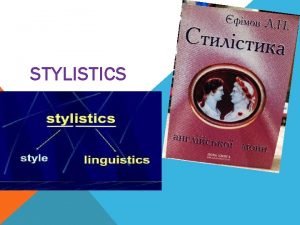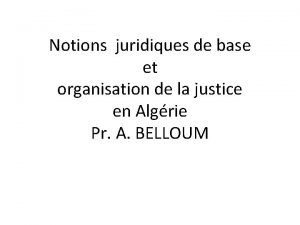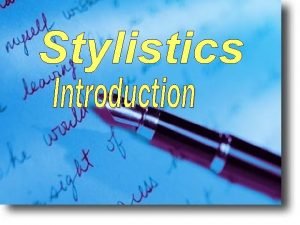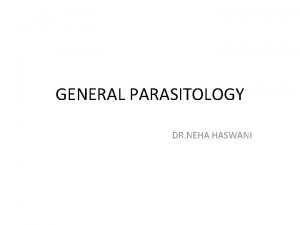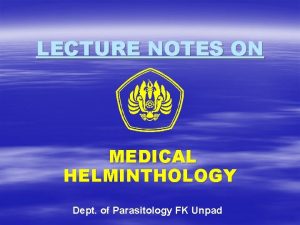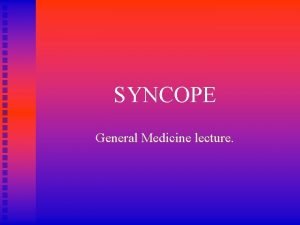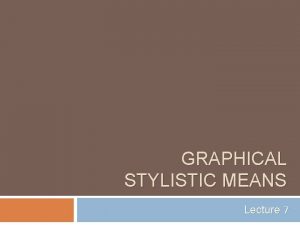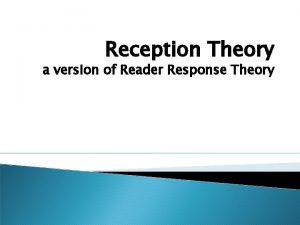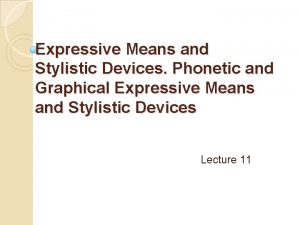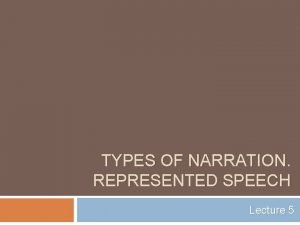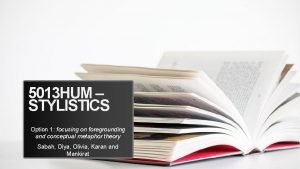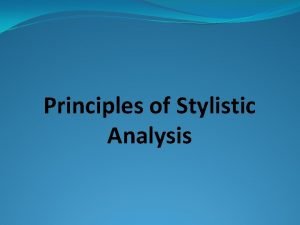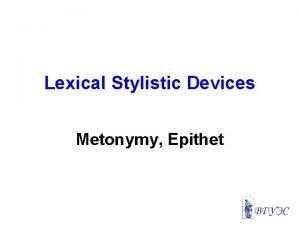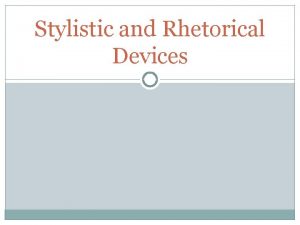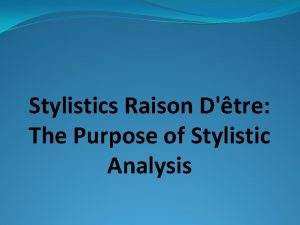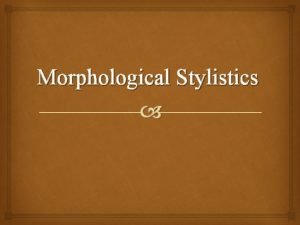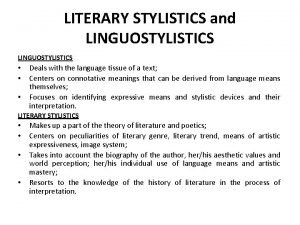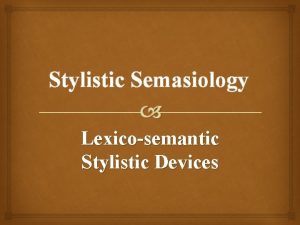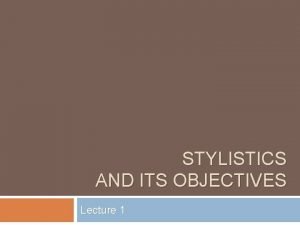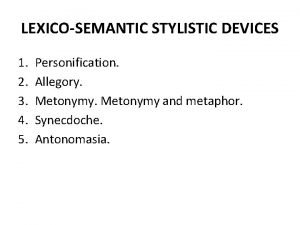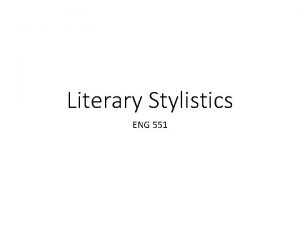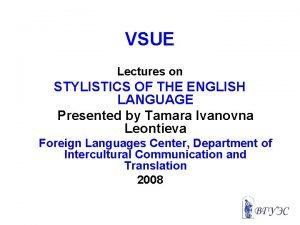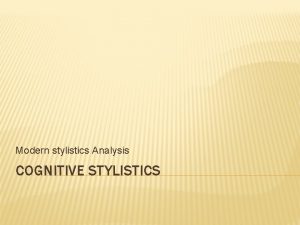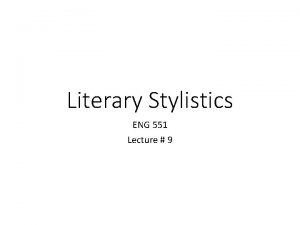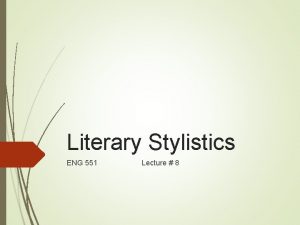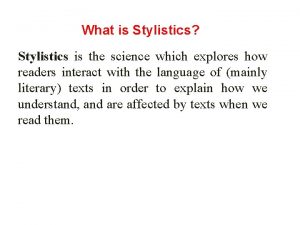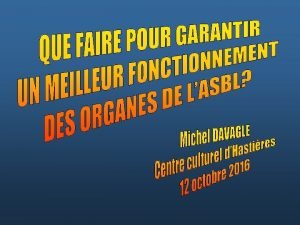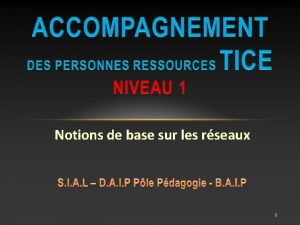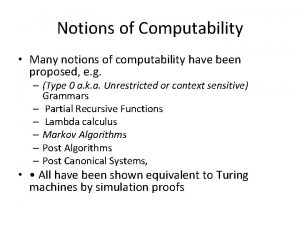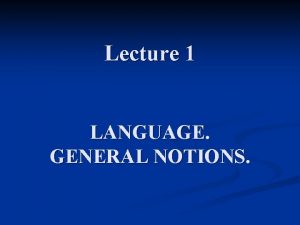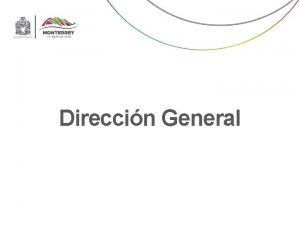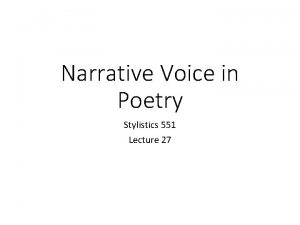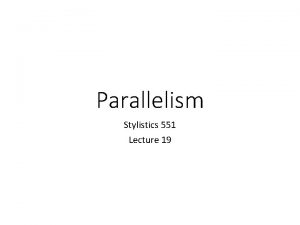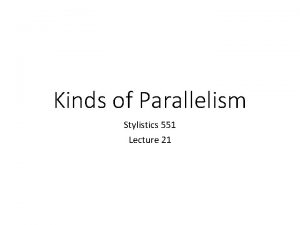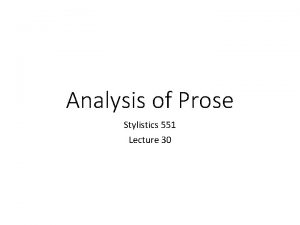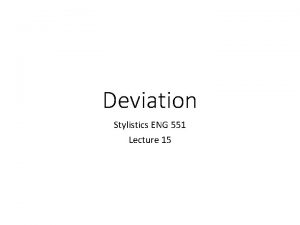STYLISTICS Lecture 1 General notions of Stylistics 1




























- Slides: 28

STYLISTICS

Lecture 1. General notions of Stylistics 1. Object and subject matter of Stylistics. 2. Types and kinds of Stylistics. 3. Expressive means and Stylistic devices. 4. Style. Speech functional styles. Individual style

1. OBJECT AND SUBJECT MATTER OF STYLISTICS Stylistics is a unique discipline. It studies the units of all language levels (from phonological to textual ones) Stylistics is interested in functioning of both stylistically colored and stylistically neutral units in communication.

The subject matter of Stylistics is studying the means of realization of the main and additional functions of the language that make speech activity effective. Language functions: v. Cognitive-reflective (nominative) v. Communicative v. Volitional v. Emotive v. Appealing or attracting attention v. Phatic (establishing contact) v. Social etiquette v. Aesthetic

The aim of communication is Ø to influence the speaker, Ø to change the emotional, physical state of the addressee. Ø This pragmatic aim is achieved when the speaker uses different language units, gestures, intonation which would largely depend on the situation.

Stylistics is a linguistic discipline which studies nominative and communicative language units and the principle of these units selections and combinations for the sake of achieving some pragmatic aim in different communicative situations. Stylistics is concerned with such issues: 1) The aesthetic function of the language; 2) Expressive means in language; 3) Synonymous ways of rendering one and the same idea; 4) Emotional coloring in language; 5) A system of special devices, called stylistic devices (CDs); 6) The splitting of the literary language into a separate system, called style; 7) The individual manner of an author making use of the language.

Ø The object of Stylistics is versatile and multidimensional. Ø It’s essential that we look at the object of Stylistics study as a holistic one, composed of several inseparable parts.

2. TYPES AND KINDS OF STYLISTICS Types: v. Linguostylistics • Functional stylistics • Stylistic lexicology • Stylistic phonetics (phonostylistics) • Stylistic grammar • Stylistic semasiology (rhetorics) v. Literary stylistics (discourse stylistics) • Genetic stylistics • Decoding stylistics • Immanent stylistics v. Comparative stylistics

Literary and linguostylistics have some meeting points. Both study: 1. The literary language from the point of view of variability; 2. The idiolects (individual speech of a writer); 3. Poetic speech that has its own specific language. Comparative stylistics is connected with the contrastive study of more than one language. It analyzes the stylistic resources not inherent in a separate language but at the crossroads of 2 languages or 2 literatures and is obviously linked to theory of translation.

Linguostylistics: v Richard Ohmann (1964) v V. D. Levin (1971) v J. P. Thorpe (1969) v D. Burton (1982) It studies • functional styles in their development and current state; • The linguistic nature of the expressive means of the language in their systematic character and their functions.

Functional stylistics is a branch of linguistics that studies functional styles, that is special sublanguages or varieties of the language, such as scientific, colloquial, business, publicist, etc. Stylistic lexicology studies the semantic structure of the word and the interrelation (or interplay) of connotative and denotative meanings of the word as well as the interrelation of the stylistic connotations of the word and the context. Stylistic phonetics (phonostylistics) is engaged in the study of the style-forming phonetic feature of the text. It describes the periodic feature of prose or poetry and pronunciation.

Stylistic grammar v Stylistic morphology is interested in the stylistic potential of specific grammatical forms and categories such as the number of the Noun, tense forms of the Verb. v. Stylistic syntax has to do with the expressive order of words, types of syntactic links, figures of speech. It also deals with bigger units from paragraphs onwards. Stylistic semasiology (rhetorics) considers additional meanings of linguistic units used as expressive means and stylistic devices of the language, their interaction and changes they undergo in fiction and non-fiction texts.

Literary stylistics: Genetic Stylistics (Leo Spitzer 1887 -1960) ü From the author’s point of view ü Considers the epoch, the historical situation, the personal political, social and aesthetic view of the author. Decoding stylistics (L. V. Shcherba, I. V. Arnold) ü From the reader’s point of view: ü Disregards the background knowledge and gets the maximum information from the text itself. Immanent stylistics (R. Jackobson, T. G. Vinokur) ü An attempt to harmoniously combine the two methods of linguistic research.

Literary stylistics • The composition of a work of art; • Various literary genres; • The writer’s outlook (D. Crystal (1987), H. G. Widdowson (1992)

3. Expressive means and Stylistic devices In linguistics there are different terms to denote those particular means by which a writer obtains his effect. Expressive means, stylistic devices and other terms are all used indiscriminately. All stylistic means are divided into: a) expressive means; b) stylistic devices.

The expressive means are those: 1. phonetic means; 2. morphological forms; 3. means of word-building; 4. lexical forms; 5. phraseological forms; 6. syntactical forms, all of which function in the language for emotional or logical intensification of the utterance

The most powerful expressive means of any language are phonetic. The human voice can indicate subtle nuances of meaning. Melody, stress, whispering, pausation, intonation and other ways of using the voice are more effective than any other means in intensifying the utterance emotionally or logically. Among the morphological expressive means the use of the Present Indefinite instead of the Past Indefinite must be mentioned first. It is named the Historical Present. In describing some past event the author uses the present tense, thus achieving a more vivid picture of what was going on.

Or the use of “shall” in the 2 nd and 3 rd person may also be regarded as an expressive means. Compare the following synonymous statements: 1. He shall do it (=I shall make him do it – threat). 2. He has to do it (=It’s necessary for him to do it). Among word-building means we find many forms which serve to make the utterance more expressive and fresh. The diminutive suffixes as –y (ie), -let (e. g. dearie, streamlet) add some emotional coloring to the words.

At the lexical level there a great many words which due to their inner expressiveness, constitute a special layer. There are v words with emotive meaning only (like interjections – Oh, Ah, Wow); v words which still retain a twofold meaning; denotative or connotative, or v words belonging to special groups of literary English or of non-standard English (poetic, archaic, slang). The expressive power of these words cannot be doubted, especially when they are compared with the neutral vocabulary.

Phraseological level. The same can be said of the setexpressions of the language (e. g. when in Leeds: our farewell party, my speech: “I’ve got a frog in my throat…”). Proverbs and sayings as well as catch-words, idioms form a considerable number of language units which serve to make speech more emphatic. Example: (In every-day speech you often hear such phrases as “I will only add fuel to the fire”, which can easily be replaced by synonymous neutral expressions, like “It will only make the situation worse”.

At the syntactical level there are many constructions which, being set against synonymous ones, will reveal a certain degree of logical and emotional emphasis. Ex. : 1. I have never seen such a film. 2. Never have I seen such a film. 3. Mr. Smith came in first. 4. It was Mr. Smith who came in first. The second structure in each pair contains emphatic elements. They cause intensification of the utterance. There are many other syntactical patterns which serve to intensify emotional quality: Isn’t she pretty! Fool that he was!

Stylistic device is formed in speech due to linear relations formed in the text or utterance between stylistically marked and stylistically unmarked units of a lower level within a unit of a higher level. Interplay of dictionary and contextual meaning is based on the principle of affinity: My new dress is as pink as this flower. - comparison

4. Functional styles: Functional Style is a system of interrelated language means serving a definite aim in communication. It is the coordination of the language means and stylistic devices which shapes the distinctive features of each style and not the language means or stylistic devices themselves. Each style, however, can be recognized by one or more leading features which are especially conspicuous.

A style of language can be fined as a system of coordinated, interrelated and inter-coordinated language means intended to full-fill a specific function of communication and aiming at a defined effect. Style of language is a historical category. The English literary system has evolved a number of styles easily distinguishable one from another. They are not homogeneous and fall into several variants of having some central point of resemblance or better to say. All integrated by the invariant - i. e. the abstract ideal system.

A functional style of language is a system of interrelated language means which serves a definite aim in communication. (Galperin) It appears mainly in the literary standard of language.

According to I. Galperin: Belles-lettres style Publicist style Newspaper style Scientific prose style Official documents style

According to I. Arnold Poetic style Scientific style Newspaper style Colloquial style

According to Yu. Skrebnev, style is a specificity of sublanguage. The number of sublanguages and styles is infinite.
 Basic notions of stylistics
Basic notions of stylistics What are the basic human aspirations
What are the basic human aspirations Les notions de base du marketing
Les notions de base du marketing Notions juridiques de base
Notions juridiques de base What is style in linguistics
What is style in linguistics 01:640:244 lecture notes - lecture 15: plat, idah, farad
01:640:244 lecture notes - lecture 15: plat, idah, farad General parasitology lecture notes
General parasitology lecture notes Wormhost chest worm locations
Wormhost chest worm locations General medicine lecture
General medicine lecture Diferencia entre gran plano general y plano general
Diferencia entre gran plano general y plano general Where did general lee surrender to general grant?
Where did general lee surrender to general grant? Graphic means of stylistics
Graphic means of stylistics Definition of reader response theory
Definition of reader response theory Expressive means examples
Expressive means examples Graphon stylistics
Graphon stylistics Speech style
Speech style Internal and external deviation in stylistics
Internal and external deviation in stylistics What is foregrounding in stylistics
What is foregrounding in stylistics Antonomasia types
Antonomasia types Understatement rhetorical device
Understatement rhetorical device Purpose of stylistics
Purpose of stylistics Textual medium in stylistics
Textual medium in stylistics Morphological expressive means
Morphological expressive means Cilimangaro
Cilimangaro Anronomasia
Anronomasia Stylistic colouring
Stylistic colouring Enumeration example
Enumeration example Stylistician
Stylistician Prolepsis stylistics
Prolepsis stylistics
